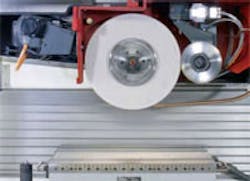Practical Ideas
Plates in No Time Flat
I remove warp and grind plates flat after heat treating using several pieces of equally spaced graphite glued to the plates. With the graphite in place, I turn the machine’s magnet strength down (if possible) and grind the graphite down to about 0.010 in. I then flip the part over and clean up the other side. This produces a perfectly flat plate every time.
On-line name fmari—MariTool Pa.
I grind the warp out of plates held down on electro-magnets by backing off the hold power until I can almost move the piece by hand. I then take light passes with the convex side up to be ground – heavy passes can heat up the plate and warp it in the other direction.
Once the first side is done, I flip the plate over and grind the second side, again using light passes.
On-line name Chris999 Rochelle, Ill.
Simple Circular Saw Slices Sheet Work
My shop was converting all its die sets to quick-change arrangements, and one of the components for this job was aluminum blocks for mounting small feeders on the side of each die set. Each set required two 2 in. by 4 in. by 1.5-in. blocks which were to be cut from a 1.5-in.-thick sheet measuring 4 ft by 12 ft.
While it was initially thought to cut out the blocks using a vertical bandsaw, we opted to use a circular saw, such as one you’d find at a hardware store, with carbide blades. The cutting went a lot faster.
I set the plate on steel saw horses, scribed out the lines for the blocks and equipped myself with ear plugs, coveralls, and gloves. The first 12-ft-long cut took about 7 min, during which, a coworker sprayed the sawblade with W-D 40. After cutting all the long strips from the sheet, we stacked 4 or 5 of them together and cut them to length in a gravity-feed Kalamazoo bandsaw.
Cutting aluminum plate with a circular saw works great, but it is a loud and messy process. However, with a steady hand and plenty of W-D 40, the process produces cut edges that look as if they had been machined. But note, it is a two-man job, one cutting and the other spraying W-D 40 and holding the back side as the saw moves along.
On-line name hyskilevel Brimfield, Ill.
Ideas for Jaw Chuck
For me, this is the fastest way to dial-in a 4-jaw chuck.
After rough aligning to the chuck rings, I use a dial indicator on the workpiece, rotate the spindle through one complete revolution and note the highest and lowest indicator readings. I then continue rotating the spindle and halt at exactly midway between those two readings (high and low) and zero the indicator bezel to the needle.
I rotate the spindle to bring jaw #1 “on plunger” and adjust jaws #1 and #3 to re-zero the indicator. At this point, I rotate the spindle 90 degrees and adjust jaws #2 and #4 to once again zero the indicator. And, I’m done.
On-line name Bob R. Northern Calif.
